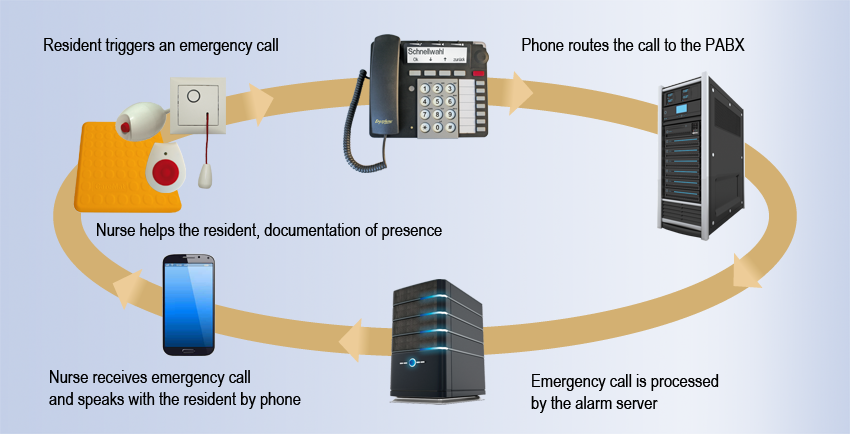.
Telephone-emergency-systems for care homes and assisted living
The Ergophone telephone forms the central unit of the emergency call system. Emergency calls are triggered and sent to the telephone via radio-controlled and/or wired transmitters/switches. The phone forwards the calls via the PBX to an alarm server or programmed call numbers. The radio transmitters/switches are quickly and easily installed and ready for use. In case of home renovations or new buildings cables can be laid for cord pull switches in bathroom and bedroom as an alternative to the radio system.
Analog technology
The use of existing infrastructure is one of the great advantages of the system. Telephone sockets and telecommunications systems are available in many care homes. The alarm server is integrated into the IT network and takes over the control of emergency calls and fault messages.
Suitable telephones:
- Ergophone S 510 radio (for wired and radio controlled emergency call systems)
- Ergophone S 500 (for wired emergency call systems)
Voice over IP
Instead of using analog telecommunication lines, digital Ergophone telephones can be connected directly to the existing LAN network. The devices are constantly monitored by appropriate servers and offer a wealth of information and control options.
Suitable telephones:
- Ergophone S 510 IP radio (for radio controlled emergency call systems)
- Ergophone S 510 IP

The illustration shows the Ergophone call triggers and the Ergophone telephone in conjunction with system components of other manufacturers.
Resident emergency call without clinic atmosphere
The Ergophone telephone ensures discreet call processes. The usual illuminated displays above the doors of residents' rooms are no longer necessary. Thus personal emergency calls are not made public on corridors and the personal rights of the residents are protected.
Leaflet "Ergophone Telephones - Areas of Application"
Relief for the nursing staff
The possibility of a direct speech connection after an emergency call enables the nursing staff to clarify the situation before the caller's apartment is visited. This may save costs and ways.
If help is provided on site, the caregiver registers to the telephone via a key of the phone or an RFID chip, looks after the resident and deregisters. The documentation of presence is made available via the alarm server for further processing.
Safety in all rooms
The emergency call system is modularly expandable with wired call triggers and radio components. In addition to the telephone, a smoke detector in the bedroom, a cord pull switch in the bathroom and, if necessary, a radio pendant on the wrist are usually sufficient to reliably protect people and property.
Failure monitoring
The multi-level safety concept includes all system components. All connected call triggers are monitored by the telephone. The phone reports faults to the alarm server, which monitors as an integrator permanently both the PBX and the telephone. Fault messages on the telephone are both displayed locally and forwarded.
